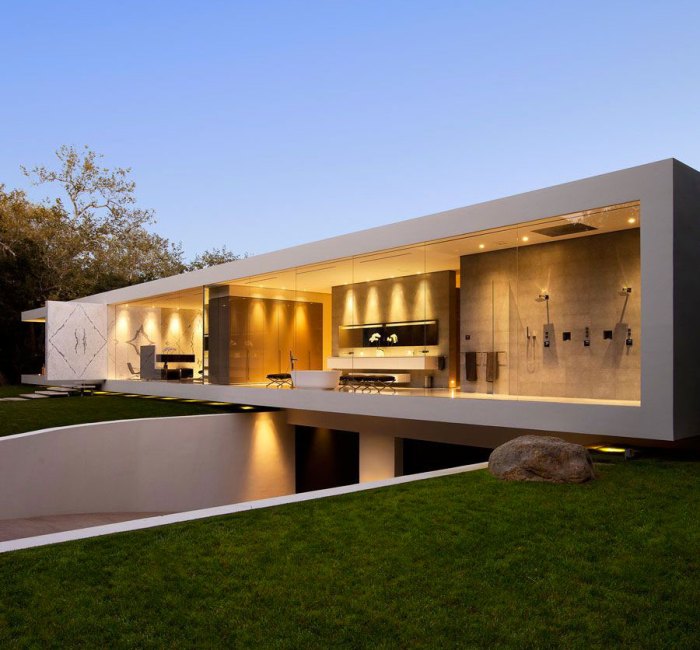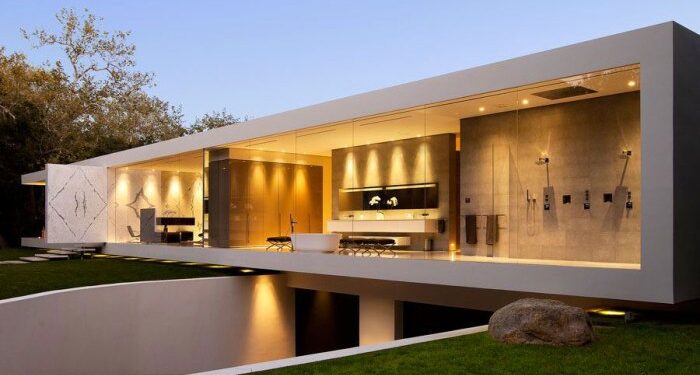Exploring the realm of Minimalist architecture house design ideas introduces a harmonious blend of simplicity and sophistication. This architectural style embraces clean lines, open spaces, and a focus on functionality, creating homes that offer both aesthetic appeal and practicality. Let's delve deeper into the world of minimalist architecture and discover how it can transform living spaces into serene sanctuaries of modern design.
Minimalism is not just a design choice but a lifestyle, where less is more and every element serves a purpose. From renowned minimalist architectural wonders to the fundamental principles of minimalism in house design, this discussion will unravel the essence of this captivating style.
Minimalist Architecture House Design Ideas
Minimalist architecture in house design focuses on simplicity, clean lines, and open spaces. It aims to reduce a building to its necessary elements, emphasizing functionality over decoration.
Key Characteristics of Minimalist Architecture
Key characteristics of minimalist architecture include:
- Simple geometric forms
- Neutral color palettes
- Use of natural light
- Clean and uncluttered spaces
Famous Minimalist Architecture Houses
Examples of famous minimalist architecture houses around the world include:
- Villa Savoye in France by Le Corbusier
- Fallingwater in Pennsylvania by Frank Lloyd Wright
- Barbican Estate in London by Chamberlin, Powell and Bon
Principles of Minimalism in Architecture
The principles of minimalism in architecture include:
- Less is more
- Focus on essential elements
- Emphasis on functionality
- Elimination of unnecessary ornamentation
Importance of Simplicity and Open Spaces
Simplicity, clean lines, and open spaces are crucial in minimalist architecture as they create a sense of calm and tranquility. They allow for better flow of natural light and promote a feeling of spaciousness, making the design both aesthetically pleasing and practical.
Minimalist Interior Design Elements
In minimalist interior design, less is more. The focus is on simplicity, clean lines, and a sense of openness. Natural light and materials play a crucial role in creating a calm and serene environment. Let's delve into the essential elements of minimalist interior design.
Use of Natural Light and Materials
Natural light is key in minimalist interiors as it helps to create a sense of spaciousness and airiness. Large windows, skylights, and glass doors are often used to maximize the influx of natural light. When it comes to materials, minimalist design favors natural elements such as wood, stone, and metal.
These materials add warmth and texture to the space while maintaining a clean and modern aesthetic.
Color Palette in Minimalist Interiors
The color palette in minimalist interiors is typically neutral and monochromatic. White, beige, gray, and black are commonly used to create a sense of calm and simplicity. These neutral hues serve as a backdrop for key design elements and allow natural light to bounce around the room, enhancing the feeling of openness.
Tips for Achieving a Minimalist Look
Declutter
Keep only the essential items and remove any unnecessary clutter.
Focus on Functionality
Choose furniture and decor pieces that are both functional and aesthetically pleasing.
Embrace Negative Space
Allow for empty spaces to create a sense of balance and harmony.
Opt for Simple Lines
Choose furniture with clean lines and minimal ornamentation
Incorporate Texture
Add visual interest with textures like smooth wood, soft fabrics, and sleek metal finishes.
Functional Minimalist Spaces
Minimalist architecture and interior design prioritize functionality alongside aesthetic appeal. The concept of functionality in minimalist spaces revolves around the idea of simplifying and decluttering to create a space that serves its purpose efficiently while maintaining a clean and visually appealing look.
The Role of Furniture and Storage Solutions
In creating functional minimalist spaces, furniture and storage solutions play a crucial role. Furniture pieces in minimalist design are often multi-functional, serving more than one purpose to maximize space utilization. For example, a coffee table with built-in storage or a sofa that can be converted into a bed are common in minimalist homes.
Storage solutions like hidden cabinets, wall-mounted shelves, and under-bed storage help keep the space organized and clutter-free.
Optimizing Space in Minimalist House Design
To optimize space in a minimalist house design, every square inch must be utilized efficiently. This can be achieved through clever storage solutions, eliminating unnecessary items, and incorporating furniture with clean lines and a minimalistic aesthetic. Utilizing vertical space with tall shelves or cabinets, using light colors to create an illusion of space, and incorporating smart technology for automation and efficiency are also key strategies in optimizing space in a minimalist setting.
Sustainable Practices in Minimalist Architecture
When it comes to minimalist architecture, sustainability plays a crucial role in not only creating a harmonious living environment but also reducing the impact on the planet. By incorporating sustainable practices, minimalist house designs can be both aesthetically pleasing and environmentally friendly.
Eco-Friendly Materials and Construction Techniques
- Utilization of recycled materials such as reclaimed wood, recycled glass, and metal can minimize waste and reduce the need for new resources.
- Implementing passive solar design by strategically placing windows and utilizing thermal mass can help regulate indoor temperatures naturally, reducing the need for heating and cooling.
- Green roofs and walls can provide insulation, improve air quality, and reduce stormwater runoff, contributing to a more sustainable ecosystem.
Energy-Efficient Solutions
- Integration of energy-efficient appliances, LED lighting, and smart home technologies can significantly reduce energy consumption in minimalist homes.
- Utilizing renewable energy sources such as solar panels or wind turbines can further decrease reliance on non-renewable resources and lower carbon footprint.
- Incorporating proper insulation, high-performance windows, and efficient HVAC systems can enhance energy efficiency and overall sustainability of minimalist house designs.
Contribution to Sustainable Living Environment
- Minimalist architecture promotes a "less is more" approach, encouraging thoughtful consumption and reducing unnecessary waste in building materials and resources.
- By creating functional spaces that prioritize quality over quantity, minimalist designs can lead to a simpler and more sustainable lifestyle for occupants.
- The emphasis on clean lines, open layouts, and natural light in minimalist architecture enhances the connection between indoor and outdoor spaces, fostering a greater appreciation for nature and promoting sustainable living practices.
Conclusive Thoughts

In conclusion, Minimalist architecture house design ideas offer a refreshing perspective on creating living spaces that are both visually stunning and highly functional. By embracing simplicity, clean lines, and sustainable practices, minimalist homes epitomize modern elegance and timeless appeal. Dive into the world of minimalist architecture and embark on a journey to transform your living space into a sanctuary of style and serenity.
FAQ Resource
How can I incorporate minimalist design in a small space?
To maximize a small space with minimalist design, focus on decluttering, using multi-functional furniture, and opting for a neutral color palette to create an illusion of openness.
What are some key elements of minimalist interior design?
Key elements include clean lines, simple geometric shapes, a limited color palette, uncluttered spaces, and a focus on natural light and materials.
Is minimalist architecture suitable for a family home?
Yes, minimalist architecture can be adapted to suit a family home by incorporating storage solutions, durable materials, and maintaining a balance between aesthetics and functionality.
How can sustainability be integrated into minimalist house design?
By using eco-friendly materials, energy-efficient solutions, and implementing sustainable construction practices, minimalist house design can contribute to a more environmentally friendly living environment.



